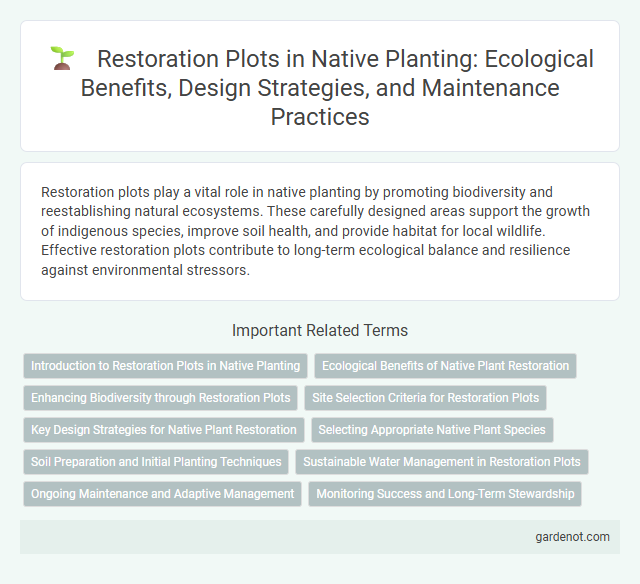Restoration plots play a vital role in native planting by promoting biodiversity and reestablishing natural ecosystems. These carefully designed areas support the growth of indigenous species, improve soil health, and provide habitat for local wildlife. Effective restoration plots contribute to long-term ecological balance and resilience against environmental stressors.
Introduction to Restoration Plots in Native Planting
Restoration plots are designated areas where native plants are systematically reintroduced to revive ecosystems and enhance biodiversity. These plots facilitate the recovery of soil health, support local wildlife habitats, and promote ecological balance by mimicking natural plant communities. Effective restoration relies on selecting native species adapted to the specific site conditions and employing techniques like seed sowing and controlled planting.
Ecological Benefits of Native Plant Restoration
Native plant restoration in restoration plots enhances biodiversity by providing essential habitat and food sources for local wildlife, including pollinators and birds. These plants improve soil health through natural nutrient cycling and erosion control, promoting long-term ecosystem stability. Integrating native species supports resilience against climate change by sustaining native ecosystems and improving water retention.
Enhancing Biodiversity through Restoration Plots
Restoration plots significantly enhance biodiversity by reintroducing native plant species that support diverse insect and wildlife habitats. These areas create ecological niches, improve soil health, and increase plant species richness, fostering ecosystem resilience. Targeted planting in restoration plots helps restore native pollinators and bird populations, promoting balanced natural communities.
Site Selection Criteria for Restoration Plots
Restoration plots require site selection criteria that prioritize soil health, native seed source proximity, and existing vegetation community compatibility to ensure successful native plant establishment. Assessing factors like hydrology, sunlight exposure, and disturbance history strengthens the plot's potential for long-term ecological resilience. Choosing sites with minimal invasive species presence and adequate space for plant growth optimizes restoration outcomes and biodiversity enhancement.
Key Design Strategies for Native Plant Restoration
Restoration plots for native plant restoration emphasize soil health by integrating organic amendments and minimizing disturbance to support native seedling establishment. Strategic placement of native species considers microhabitats and revegetation goals to enhance biodiversity and ecosystem resilience. Utilizing locally sourced native seeds ensures genetic diversity and improves long-term survival rates within restoration efforts.
Selecting Appropriate Native Plant Species
Selecting native plant species for restoration plots involves evaluating local climate, soil conditions, and historical vegetation to ensure ecological compatibility. Utilizing region-specific databases and consulting with native plant experts enhances species selection, promoting biodiversity and habitat resilience. Prioritizing native perennials and wildflowers supports pollinator populations and stabilizes ecosystem functions within restoration areas.
Soil Preparation and Initial Planting Techniques
Restoration plot success depends heavily on thorough soil preparation techniques such as removing invasive species, tilling, and incorporating organic matter to enhance nutrient availability and soil structure. Initial planting techniques include selecting native species with appropriate rooting depth and spacing to promote healthy growth and biodiversity. Utilizing methods like direct seeding or container planting ensures better establishment and long-term soil stabilization in restoration efforts.
Sustainable Water Management in Restoration Plots
Restoration plots utilizing native planting enhance sustainable water management by improving soil infiltration and reducing runoff. Deep-rooted native species increase groundwater recharge while minimizing erosion and nutrient leaching. Integrating diverse native plants creates resilient ecosystems that maintain hydrological balance and support long-term water quality.
Ongoing Maintenance and Adaptive Management
Ongoing maintenance in restoration plots ensures the survival and health of native plant species by controlling invasive species, watering during drought periods, and monitoring soil conditions. Adaptive management involves regularly assessing plant growth data and environmental changes to adjust techniques such as replanting density or species composition. This dynamic approach maximizes ecosystem recovery and supports long-term biodiversity goals.
Monitoring Success and Long-Term Stewardship
Effective monitoring of restoration plots involves regular data collection on plant survival rates, species diversity, and soil health indicators to gauge ecosystem recovery. Long-term stewardship requires adaptive management strategies that incorporate ongoing invasive species control, habitat enhancement, and community engagement to ensure sustainable native plant establishment. Integrating remote sensing technology with field observations enhances precision in tracking restoration progress and informs future conservation decisions.
Restoration plot Infographic

 gardenot.com
gardenot.com